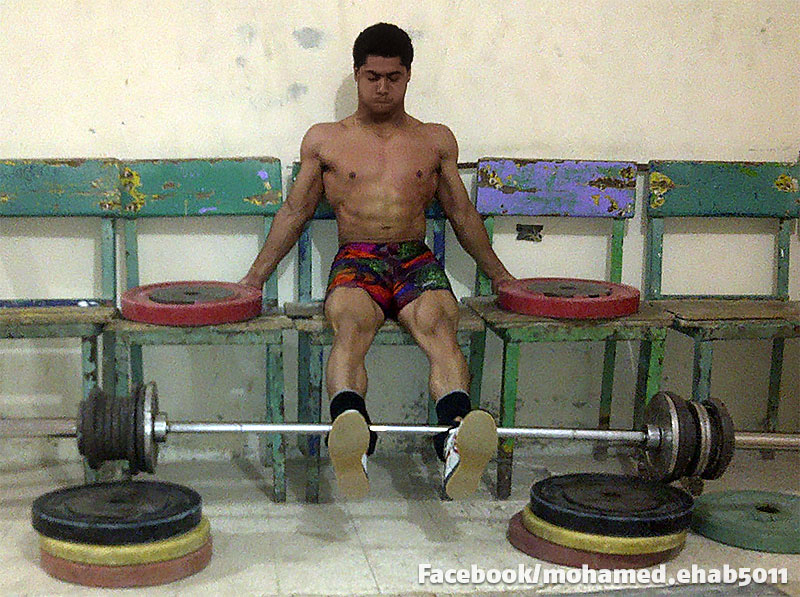I recently came across a photo of Mohamed Ehab (155kg Snatch) doing some low tech Isometric Leg Extension Holds.
So I asked him about some details about this exercise. He does:
- 3 sets
- 20 second static hold
- with 90kg
He uses it for
the prevention of injuries, especially the knee joint.
Very difficult, but very useful.
Have you used this exercise? Maybe some coaches/ PTs can chime in and explain potential benefits.

Photo Credit: Mohamed Ehab on Facebook
Then I remembered seeing this exercise in a couple of the Chinese training videos.
Check the video below at 1:17 for example (thanks for finding it Sam!). This is Liu Chunhong, 2x Olympic Champion and World Record holder @ 69kg (Thanks Finsnatcher).
sounds like it would pump your quads in a hurry.
You could argue this exercise helps with strengthening the vastus medialis oblique (tear drop muscle). This will benefit patellar tracking and reduce the possibilities of wear and tear. Its a common exercise used in rehabilitation from acl or patellar injuries early on (with much less weight of course). It is pretty interesting to see them using such heavy loads. Im guessing this is anatomical adaptation work for him.
Interesting, thanks for the input.
While I see the point of doing extensions in rehab process, I always thought its a dangerous exercise especially done with heavier weight. I may be wrong, but I never really liked the feeling in my knee when doing this exercise (the regular not isometric), and I quit doing it very soon.
I also have mixed feelings about normal extensions… The holds however intrigued me, hence the post to get some opinions on them.
I agree, heavy load should not be implemented all the time. These types of exercises are more about neurological training, as contrary as that might sound.
I’m not a PT or anything, but isometric exercises also have been shown to likely increase natural HGH production, however anecdotal/useful that information may be.
“This will benefit patellar tracking and reduce the possibilities of wear and tear”
“Its a common exercise used in rehabilitation from acl or patellar injuries early on (with much less weight of course).”
This is an outdated thought process. The rehab community has been doing this wrong for years. If the goal with this exercise is to strengthen the quadriceps, great! I think it helps to achieve that. However, to make the claim that it will maximize patellar tracking and prevent injury is purely anecdotal and done without scientific backing. You could make the counter-point that it actually increases retro-patellar forces and can attribute to anterior knee pain more than inhibit it. Just a thought…..
See recent research by Chris Powers PT, PhD out of University of Southern California Biomechanics dept with regards to the glute medius/maximus being the more dominant muscle in closed chain positions (ie: squatting) compared to the quads (VMO in particular) when performed under dynamic MRI. His information is readily available for the savvy internet user.
Colin Rigney PT, DPT, OCS
Addendum: Powers’ studies are all in regard with comparing VMO/quad vs gluteal muscle training with respect to patellofemoral pain. IE: which muscles/positions are more important in rehabbing/preventing anterior knee pain, glutes or quads? Squats or leg extensions? Most evidence shows that leg extension-like movements, being isotonic, eccentric or isometric have the potential to cause more harm than provide therapeutic benefit.
i literally wanted to post almost exactly that. well done
And the chinese woman doing the holds is Liu Chunhong, 2x Olympic Champion and World Record holder @ 69kg
finsnatch is not me, so please don’t give me credit for identifying Liu
What I personally like about this exercise or doing slow single leg eccentric leg extensions is the increased blood flow to the quads witch I believe helps repair the tendons and muscles.
Have nothing to back this up except for having dealt with quadricep tendonitis and used this technique(effectively) for that.
Worth noting that a physio recently pointed out to me that I barely use my glutes at all when squatting and I have been steadily working on that now. You can feel the difference when using the glutes how it’s easier to hold your posture upright. Shame how far behind they are from my quads, it’s going to take a while for them to catch up!
I find that one of my glutes works harder than the other which is also annoying.
How do you work on activating yours more? I squeeze my glutes, especially the weak side through out the day to get that mind-muscle connection going.
The physio had me squeeze my glutes real hard when standing and squat down while keeping them as tight as possible! So basically just practice that motor pattern of having the glutes activated through out the whole squat, and thinking about squeezing the glutes to drive you up out of the hole. You can really feel that if you drop down to full depth, stop for a moment, squeeze your glutes and let them drive you up.. Apart from that I stretch my hip flexors with bands and do some unilateral/bilateral bridges!
Yeah, I have started doing the contraction thing too. Have to try some unilateral bridges too. Thanks for the tip.
I have been training Kyokushin for some months. My shihan came from a very traditional background and lived in Japan for more than 20 years. He has seen a lot of injuries and has a deep knowledge about them, particularly knee and ankle injuries. The only thing he insists a lot for me to train at gym is isometric leg extensions.